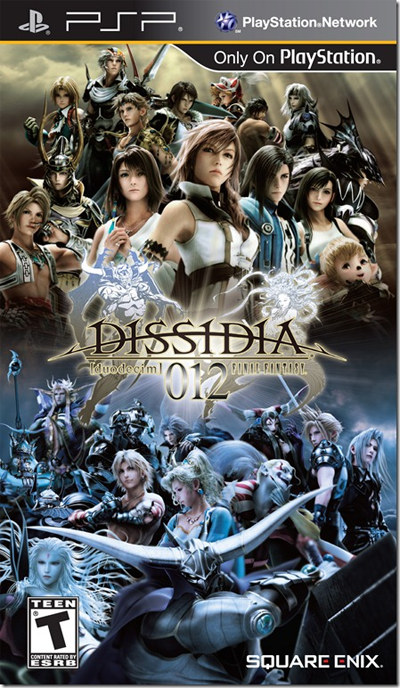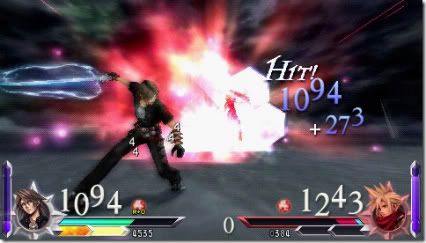
- Format: PSP
- Unleashed: Out Now
- Publisher: Square Enix
- Developer: Square Enix
- Players: 1-2
- Site: http://www.dissidia012game.com
The original Dissidia is amongst the most bizarre genre mixing games in existence. It mixed heroes and villains from every generation of Final Fantasy and pitted them against one another in extravagant battles under the pretence of being chosen to fight for one of two rival gods. Ever one for making things needlessly complicated, Square Enix has now released Dissidia 012 [duodecim]: Final Fantasy which, other than having a terrible title, is in fact a prequel and a re-release of the original game.
The story mode once again places players on the side of Cosmos fighting against Chaos, in an overly ambitious plot that acts as no more than a means to service fans. Still – your favourite Final Fantasy cast members are stuck in an endless cycle of war. The new cast of the game in Cycle 012 band together to give themselves a better chance of ending the war in Cycle 013 (the subject of the first game) by halting the creation of manikins.
Playing as Lightning, Laguna, Vaan, Yuna, Tifa and Kain through their struggle to prepare for Cycle 013 will take at least 15 hours, but after that you also gain access to Cycle 013 should you want to replay the first game (or see it for the first time). There is also an unlockable Cycle 000 that acts as a ‘what-if’ where you can create a party of any characters you want, regardless of affiliation, to tackle the highest level manikins.
 The inclusion of the whole of the first game was quite surprising. The plot, cutscenes and most of the content has not changed, but along with the familiar chessboard style dungeons are new open world areas, as introduced in 012. These allow you to hunt down manikins and also include optional dungeons, treasure, and smart-mouthed Moogles that sell rare equipment and summons.
The inclusion of the whole of the first game was quite surprising. The plot, cutscenes and most of the content has not changed, but along with the familiar chessboard style dungeons are new open world areas, as introduced in 012. These allow you to hunt down manikins and also include optional dungeons, treasure, and smart-mouthed Moogles that sell rare equipment and summons.
Outside of the story modes the plethora of other options available on a single UMD is quite staggering. You have standard 1-on-1, and also team matches for up to 5-on-5; a labyrinth which is part card game, part random dungeon exploration; an arcade mode; a time attack mode; a friend card system and friend card ghost battles. Enjoying these does depend on not tiring of the battle system (which will happen sooner or later) but from a content-to-price comparison, Dissidia 012 scores highly.
It’s a challenge to accurately summarise the battle system in Dissidia in this space. Beyond characters having their standard HP (health) they also have Bravery and two types of attacks based on both. When an HP attack is successfully struck on your opponent, the damage to their HP is directly proportionate to your current Bravery. Upon expending your supply of Bravery it resets to zero, slowly building back up to your base amount, leaving you exposed for a counter attack which may lead to a Break happening.
A Break is when a character with no Bravery has their Bravery attacked. During this status a successful HP attack will deal no damage and the person who managed to inflict Break on their opponent is also granted the accumulated Stage Bravery, giving them a significant advantage in battle.
 Summonstones return as do EX Modes (special transformations that give access to a character’s best attack) and last is a new addition to the formula: Assists. As you attack, a bar will build up within two segments. If you activate with one segment filled, your chosen Assist will appear and launch a Bravery attack. If activated while both segments are full they will launch an HP attack. You can also activate Assists to escape brutal combos or otherwise fatal blows.
Summonstones return as do EX Modes (special transformations that give access to a character’s best attack) and last is a new addition to the formula: Assists. As you attack, a bar will build up within two segments. If you activate with one segment filled, your chosen Assist will appear and launch a Bravery attack. If activated while both segments are full they will launch an HP attack. You can also activate Assists to escape brutal combos or otherwise fatal blows.
One thing of interest to note for those who did play the first game is that Square Enix has fixed an exploit that used to be present. If your EX bar was filled you could wander up to your opponent, allow them to start hitting you, and then break out by activating EX Mode and landing an unavoidable EX Burst attack. In Dissidia 012 doing the same thing will instead use up the whole of the bar to activate EX Break, which slows down time for a few seconds. You can still land a free hit; but it will not link into an EX Burst, balancing things out well.
As with the first game, Dissidia 012 competently makes use of all of the PSP buttons. Uses of the shoulder buttons in combination with a face button can be a little daunting at first for a new player, but in time and with practise become second nature. What can get frustrating is the combination of the shoulder button and the triangle button in order to dash – as if you are slightly too fast you will defend in mid-air instead, leaving you exposed for a few seconds afterwards.
It is safe to assume that an interest in the characters of at least a few generations of Final Fantasy games is partially required, but regardless of who it is that you’re smashing through a pillar of rock you’ll still enjoy the feeling of doing it. Those less familiar with the games that the cast originally came from will probably offer up the most variety with their selection and will not just switch between Cloud and Sephiroth.
Unfamiliar players may enjoy the strategic battle system of Dissidia 012, but it’s worth trying it out first (either by purchasing Dissidia: Prologus on PSN or downloading the demo of the first game). For those who like Final Fantasy and want a lot of fan servicing content for their money, they will not go wrong with this game.

















Comments